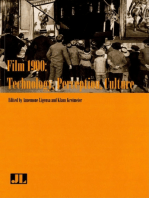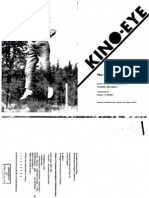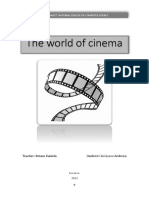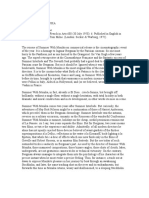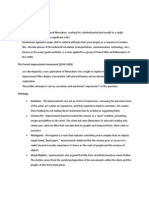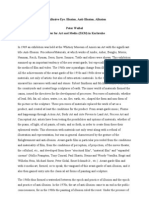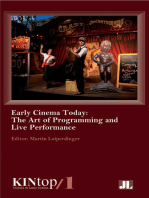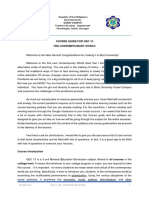Film Studies Critical Approaches Introduction
Film Studies Critical Approaches Introduction
Uploaded by
Paula_LobCopyright:
Available Formats
Film Studies Critical Approaches Introduction
Film Studies Critical Approaches Introduction
Uploaded by
Paula_LobOriginal Description:
Original Title
Copyright
Available Formats
Share this document
Did you find this document useful?
Is this content inappropriate?
Copyright:
Available Formats
Film Studies Critical Approaches Introduction
Film Studies Critical Approaches Introduction
Uploaded by
Paula_LobCopyright:
Available Formats
Introduction
There is no shortage of anthologies introducing key theories and figures in the field of
film studies. This anthology does not aim to join them. Less dutifully, our aim is not to
pay homage to the past but instead to distil key issues and problems of the contemporary
field that are, as the British Workers' Education Association once demanded of the
knowledge it sought, 'really useful' for the future. In this, the second century of moving
images, new questions, and new knowledge, animate the field. The essays collected here,
many of them published for the first time, offer not grids to be app lied, but tools of
investigation through which to open up and explore the questions that confront us at the
start of the new century. They begin by asking of the specific areas with which they are
concerned: What do we need to know now? What theories, concepts, and methodologies
will help us to know? From this starting point they move on either to reframe or to
depart from the concerns of the 1970s when film first became an academic subject of
study. The first aim of this collection is thus to explore the field in the light of these
reorientations. In the process we are not so much discarding the old questions and
knowledge, but rethinking, refiguring, and restructuring what is most useful from this
past. It is in the spirit of postmodernist self-fashioning of new identities out of old that
we call this book Reinventing film studies.
This reinvention centres around five key issues: the interdisciplinary location of film
studies as a means of engaging with the 'massness' of cinema; film understood as a
sensory as well as meaning-producing medium; the conception of cinema as
constituting an 'alternative public sphere'; history and the postmodern; and, finally, the
impending dissolution of cinema within globalised multimedia and of Western film
studies in their transnational theorisation.
First, then, film studies can no longer afford to ignore its interdisciplinary location.
For some writers in this volume film studies reinvents itself by intersecting with
neighbouring disciplines - media studies, cultural studies, visual. culture - in an
engagement with film as popular md mass cuiture. This theoreticai move relocates the
'massness' of the media at the heart of our theories of mass culture. It aims, as Jane
Gaines argues in her return to Ernst Bloch, to produce a theory for the mass rather than
about them. Previous efforts to establish film studies as a distinct field elaborated
aesthetic, psychic, and ideological structures which separated film from the mess of
movie-making and movie-going, providing disciplinary distance and professional
justification, while depending on the silent presence of the mass, interpellated as film
theory's intellectual 'other'. For its part, media studies focused on issues of mass
communications, political economy, public policy, and media imperialism, and
detached itself from the 'soft' issues of aesthetics, fantasy, and the body. Paradoxically,
Introduction
the politically despairing perception of postmodernity as the saturation of the public
sphere by the mass-produced image has driven many critics back to the Frankfurt
School. This encounter permits new readings of its work which allows us to face up to,
rather than reject out of hand, the massness of modernity and to include the analyst as
situated within, rather than outside, the mass (Chapters 6, 7, 9, and 18).
This retrieval of the massness of modernity paves the way to a second key issue of
reinvention: attention to the sensory experience of the cinematic mass medium. Where
earlier film studies had tended either to ignore or condemn the apparently mindless,
sensual, and affective pleasures of film viewing, many of the essays in this collection
confront the need to take account of movie-going as a concrete, physical experience with
distinctive, and historically changing, sensory appeal. Without shirking the 'massproduced' nature of the cinematic 'production of the senses', several authors locate this
physical-sensual appeal as the very hallmark of modernism now reconceived under the
influence ofpostmodernism (Chapters 3, 17, 18, and 19).
Film studies' suspicion of the massness of cinema rested to a large degree on the
perception of dominance - by ideology, by complicit formal structures, by an
underlying psychic substructure to which all difference would be reduced. Dominance
locked film studies into an unproductive binarism of progressive versus reactionary text.
The political point of film analysis was to separate the progressive from the ideologically
contaminated or the retrogressively nostalgic. Now the reinsertion of the body and the
affective into film reconceives the social, cultural, and aesthetic as equally significant but
distinct factors, mutually determining but not reducible to one another. This suggests
for some that ideology as formerly conceived is no longer useful as the basis of a
totalising theory of film (Chapters 6 and 11), while others argue that a way of
reconceptualising the relation of films and the political is urgently needed (Chapters 3,
5, and 20).
Understanding 'our mass-mediated culture' as the only terrain on which we have to
work has thus gradually led to a third major reinvention: the displacement ofbinarism
by a dialogical conception of the media as constituting arenas of exchange and
negotiation, in what is now conceived as an 'alternative public sphere' (Chapters 7 and
18). This shift has enabled many of these essays to reinfuse aesthetic concepts such as
realism, melodrama, genre, and fantasy with analytical purchase on the cinema's
location within mass culture and on the way it works as public sphere. Thus aesthetic
concepts that had until recently been caught up either in a deliberately self-distancing
formalism or trapped in an ideological binarism have again become useful. Many of
these essays wrest the concept of an 'imaginary' from its narrowly psychoanalytic
, J definition to define the space where reality is discursively shaped and a resulting 'social
; imaginary' becomes materially and aesthetically concrete. A key perception emerging
from these essays is the significance of the 'image' and 'imaginary' as sites of cultural
, construction (Chapter 15) and contest (Chapter 12). In particular, the rethinking and
use of genre in many of these essays (Chapters 12, 13, 15, and 18) suggest its renewed
value for exploring the location of cinema at the heart of a social imaginary. So where
genres, modes, and cultural formations were once viewed as in the service of an
overarching dominant narrative, we can now relocate them in a more complex matrix of
Introduction
cultural forms, practices, and effects that do not necessarily add up to 'master narratives'
(Chapter 3) butwhid1 Qa_.v:g pglitical purchase
TI1e present challenge of postmodernity - even if one does not accept the radical
rupture of the modern by the postmodern and of old technologies by new - has, if
nothing else, compelled a new urgency in the understanding of film history. As Tom
Gunning demonstrates in his essay on cinema's forgotten future (Chapter 17), 'written
after I 00 years of films', history is never fully about then and always about now. A fourth
reinvention thus occurs as the pressure of the notion of the postmodern has created a
new perception of the massness of the public sphere and opened up the possibility of a
new kind of history- a history for the present. The essays included in Part 4, on the
'Return to History' (Chapters r6-19),'arong~th several others (Chapters 7, 20, and 23),
share a sense of fluid identities and total mediation of all aspects of life that necessitates
a reinvention of the very concept of cinema.
The massness and global reach of film raise for some of these essays the issue of
different national conditions of modernisation. These include the ambivalent formation
of the popular in the encounter between indigenous cultural traditions, Western media
imperialism, national politics, and the appropriateness of the theories and protocols of
Western film studies. For Rey Chow, writing about Chinese cinema (Chapter 21), a key
question is how a 'third world' cinema manufactures an alterity that it gives back to the
'first world' but also what alterity it sees in its own reflection. For Ravi Vasudevan,
writing about Bombay cinema (Chapter 8), a key question is how the spectator of a
transitional/national cinema is addressed, while Ana L6pez, writing about Latin
American cinemas (Chapter 22), examines the various ways they have 'faced up' te )
Hollywood. For all of these writers the film medium constitutes a vital political issue. As
mass media break down national barriers and national attempts to reinvent discrete
cultural identities, the reviewing of film studies from positions outside the West forces
the field to a fifth arena of reinvention - remaking itself as a site of international .
exch~(Chapters 6, 8, and 20-22).
----------- __ _j
Predominantly, however, this volume - with its British and US co-editors represents a self-reflexive venture on the part of a specifically located Anglo-American
film studies. In asking 'Where is film studies now?' many of these essays localise the
grand theories that once guided the establishment of the discipline in the 1970s while at
the same time seeking more global understanding. The essays written on either side of
the Atlantic suggest the impact of their different historical, cultural, and political
locations on the development of the discipline and the uses of theory for each. The
inception of film studies in Britain outside the academy, and its continuing political
struggles for existence within it, account for a stronger sense of frustration in some of the
British essays with both the political stagnation of a 'grand theory' based on ideological
and subjective interpellation and postmodernism's apparent loss of grip on cultural
politics. In contrast, the blockage perceived in some of the American essays lies in a
textual totality which, distilled from the neo-Marxist and structuralist theoretical
ferment of the 1970s, emphasises a universal poetics and cognitive effectivity of a
narrative form remote from the mess of daily cultural practice and political demands.
Reinventingfilm studies has five sections of four to five chapters each. The first two or
Introduction
three essays of each section open up key problems, issues, and debates, exploring the
consequences of particular theoretical approaches. A case study in each section offers a
concrete example of what these approaches can deliver in relation to a particular work or
genre. Part!, 'Really useful theory', begins with questions about film meaning and film
theory, asking why we need film theory and what are the 'really useful' theories today.
Part 2, 'Film as mass culture', poses the relation of film studies to mass culture,
refiguring the nature of the Hollywood dream factory in relation to hopeful wishfulfilment, reception research, stardom, and the public sphere. Its case study looks at
Bombay cinema, one of the most popular cinemas in the world. Part 3, 'Questions of
aesthetics', tackles the formal and fantasmatic dimensions of cinema, rethinking such
key topics as the 'classical' text, ideology, genre, and aesthetics. Its case study is of a genre
that has heretofore gone unrecognised in film studies: the ubiquitous and essential trial
movie. Part 4, 'The return to history', then takes up the many new ways historians have
engaged in theoretically informed historiography, asking first what film history is, then
engaging in historical research on the mass audience's sensory involvement in the
medium. Part 5, 'Cinema in the age of global multimedia', concludes with essays
investigating local and global identities in a postmodern, international context which
includes unequal exchanges of media products and theories, a case study on the labour
of social fantasy in Chinese cinema, and new directions for technologies of multimedia.
Acknowledgements: Special thanks go to Lesley Riddle for patience and enthusiasm, to
Paul Fitzgerald, Matthew Collins, and Luke Collins for friendly sustenance, and to all our friends
and colleagues whose work and support have contributed to this book.
PART 1
Really useful theory
Editors' introduction
Most of the contributors to this section on theory agree that whatever film
theory is today it can no longer be the kind of overarching, 'grand' theory that
flourished in the 1970s. These theories tended towards tolalising philosophical
or scientific quests for big truths, whether truths of history and revolution (Marx,
Althusser), sell and identity (Freud, lacan), or language (Saussure, semiotics).
Each writer may define the nature, the pitfalls, and the ultimate value of' grand'
theory differently, but all agree that the kind of theorising about cinema that
needs to be done today must be more concretely located and, as Bill Nichols
puts it in Chapter 3, historicised. Theory must now be seen as having
debatable historical legacies rather than philosophical essences. Once placed
within these debatable contexts, Nichols argues, theories can become 'really
useful' conceptual frames within which historically situated generalisations can
address significance and value. Theory, like cinema itself, thus comes to be
seen as a socially constructed, historical category, serving socially significant
and historical and therefore politicised ends.
Geoffrey Noweii-Smith, in the opening essay, 'How films mean, or, from
aesthetics to semiotics and half-way back again', reviews the current state of
film theory by asking how the emphasis on film meaning came about and
whether it can be sustained in the relative absence of the grand theories that
once animated the field. Arguing that the grand theories of history, linguistics,
and psychoanalysis had displaced an earlier concern with aesthetics, NoweiiSmith illustrates the various ways in which aesthetic questions, albeit in a
different form, ore back on the agenda. Yet if Noweii-Smith, along with other
contributors to this part of the book, is critical of overarching grand theories,
he does not will the end of theory or even the end of the (now more limited and
situated) political goals and loundational concerns of many of those earlier
'grand' theories.
Part 1: Really useful theory
In similar vein, in Chapter 2, Gill Branstan dissects same al the blockages
al grand theory far those who have most practical need of it - teachers and
their students seeking to understand the work of media in the world in which
we find ourselves. Nevertheless she endorses the value of theory (and curiosity)
as '"life skills" for the twenty-first century' (page 31 ). Arguing for both the
'ordinary' nature of theory as well as its necessarily distanced and reflexive
specialisation, Branston answers the question, 'Why theory?' with an account
of some of the more modest yet irrefutable theoretical achievements that have
absolutely changed the way we think and argue about films: the recognition of
the ways realism is coded, the recognition of genres that depict repetition and
difference, and the recognition of stars as constructed.
In endorsing the kind of 'middle range theorising that moves easily from
bodies of evidence to more general arguments and implications' (page 29)
favoured by Bordwell and Carrell in their, perhaps inaptly, named book Pasttheory, Branston stresses their political value. This call to political situotedness
is pursued by Bill Nichols in Chapter 3. He vigorously argues the value for film
theory of three key concepts- visual culture, representation, and rhetoric- that
retain a foundation in grand theory but provide a more culturally and
multiculturolly sensitive perspective. While not specific to film theory, but rather
inhabiting a cultural studies framework, these concepts, unlike the cognitive
psychology of Bordwell, enable us to think about film in relation to the social,
political, and identilicatory concerns that motivated grand theory but in more
historically and locally specific ways. These concepts are broad and fluid
enough to situate film studies within larger interdisciplinary frameworks within
which it can carry on conversations that will continue to vitalise its work.
Nichols interestingly situates film studies, along with other new disciplines
such as women's studies and gay and lesbian studies, within a problematic of
cultural visibility that encompasses both cultural difference and the appeal to
the senses os a crucial, but often unacknowledged, form of knowledge
production. Thus visual culture, a field of study and a conceptual frame that
extends well beyond the specific medium of film, allows film studies to take up
issues such as the appeal of cinema to the senses (addressed in Part 4 in the
chapters by Hansen and Williams (Chapters 18 and 19)) that have been
dismissed in earlier theory.
Steven Cohan, in a case study on Singin' in the Rain, demonstrates the
usefulness of theory in generating film interpretation (Chapter 4). Interpreting
an enduringly popular, now canonical, musical of the 1950s from a number
of different, theoretically informed, perspectives, Cohan elegantly illustrates
how meaning changes according to the theoretical framework applied. By
demonstrating how Films exist as textual objects of inquiry thot lend themselves
to theoretically informed interpretation Cohon reasserts the value of textual
reading even os he shows how various it con be. These different perspectives
do not rigorously duplicate the march from totolising 'grand theory' to the more
situated cultural studies theories described by some of the other authors in this
Part 1: Really useful theory
section. However, the initial structuralist anolysis of the film's norrotive
opposition does follow a rough development from structuralism through
cultural studies ond queer theory. Structural opposition gives woy to a 'poststructuralist' Derridian deconstruction which gives way to a psychoonolytic
and feminist interpretation of sexual difference to a cultural studies
interpretation of Gene Kelly's star status too queering of this image. As Cohon
shows, each of these theoretical interpretations olso yields on onolytical
method ond a politics thot determines whet we see and why it motters.
In asking the question, 'Who (and what) is it for?', Tessa Parkins explores
the relationship between the academy, theory, film-making, ond politics
(Chopter 5). like Bill Nichols she revisits the 'grand theories' of the 1960s and
1970s ond the various 'turns' taken by film studies since in on attempt to
dissolve the problems they posed ond to accommodate the changing contexts
of both politico! and academic scenes. In so doing Parkins outlines a somewhat
different, British, theoretical history from that described by Nichols. For British
film studies, 'empiricism' rather then 'formalism' hos been the main problem,
with 'politics', arising outside higher education, forcing theory- especially the
'continental', neo-Marxist ond psychoanalytic kind - on to the reluctont
agendas of a number of ocademic disciplines. In the heady decodes of the
1960s ond 1970s, film theory was developed in the pages of Screen, in British
Film Institute Summer Schools, and among the widening circles of teochers,
cultural activists, and film-mokers in order to promote o larger 'film culture' as
part of an interventionist cultural politics. Tessa Parkins offers an acute analysis
of the political, theoretical, and cultural reasons for the dispersal of this energy,
while reminding us not only of its achievements but also of the paramount
importance, exemplified in the needs of marginalised, oppressed, and
unrepresented groups, of developing holistic theoretical frameworks capable
of grasping the shifting relations of capitalism, the media, audiences, and the
workings of cultural power.
How films mean, or, from
aesthetics to semiotics and
half-way back again
Geoffrey Noweii-Smith
The revolution which took place in film studies in the 1970s was, to use the jargon of the
time, highly overdetermined. It had a significant political dimension, spun off from the
radicalism of 1968. Philosophically it vaunted its materialism, in opposition to idealisms
of every kind. Thirdly (this list is not intended to be exhaustive), it was aligned with the
grand structuralist project to understand human culture as a whole in terms of patterns
of meaning.
In a sense this revolution has done its work too well. It has successfully shifted the
focus of film study. Theory has come first and foremost to concern itself with meaning,
often with the aim of bringing to the surface those aspects of meaning which can be
characterised as ideological. Meanwhile, the impulse behind the shift in focus has been
lost or mislaid, leaving unexplained the reasons why it was thought to be necessary and
what it was that the revolution set out to overthrow. Changes in intellectual fashion structuralism has been 'post'-ed and Marxism overhastily consigned to the capacious
dustbin of history- have left much of film theory high and dry, no longer supported by
the more general theories on which it used to rely.
In reviewing the current state of film theory it is therefore worth focusing on two
questions in particular: first, how did the current focus on meaning come about; and,
second, can it be sustained in the absence of the impulses that gave it force at the
beginning?
In the definition given to it by the magazine Screen in the mid-1970s, film theory was
seen as addressing three distinct but overlapping problems: the relation of the film to the
world it represents; the internal organisation of filmic discourses; and the reception of
the film by the spectator. The methodologies for investigating these problems were
derived, respectively, from historical materialism, semiotics, and psychoanalysis.
Subsequent developments have seen historical materialism sidelined, psychoanalysis
contested, and semiotics, at a scientific level, more or less abandoned. But the problem
You might also like
- La La Land in Relation To Genre TheoryDocument7 pagesLa La Land in Relation To Genre TheoryAvnish Mehra100% (1)
- Corner - Performing The RealDocument15 pagesCorner - Performing The RealPabloNo ratings yet
- Bordwell NarrationDocument22 pagesBordwell NarrationRoozbeh PNo ratings yet
- Relocating American Film HistoryDocument42 pagesRelocating American Film HistoryvaldigemNo ratings yet
- David BordwellDocument5 pagesDavid BordwellFernando Maia da Cunha100% (2)
- MIL Midterm ExamDocument2 pagesMIL Midterm ExamVivien Leigh LopezNo ratings yet
- Elsaesser - Film Studies in Search of The ObjectDocument6 pagesElsaesser - Film Studies in Search of The ObjectEmil ZatopekNo ratings yet
- Film 1900: Technology, Perception, CultureFrom EverandFilm 1900: Technology, Perception, CultureAnnemone LigensaNo ratings yet
- Framing Pictures Film and The Visual ArtDocument1 pageFraming Pictures Film and The Visual ArtlsdkdhfNo ratings yet
- Jonathan Rosenbaum - David Lynch Twin PeaksDocument6 pagesJonathan Rosenbaum - David Lynch Twin PeaksalexrgnNo ratings yet
- Database DocumentaryDocument17 pagesDatabase DocumentaryRaluca CojocaruNo ratings yet
- Pressure and Obsession in The Films of David Fincher, The Fincher AnalystDocument24 pagesPressure and Obsession in The Films of David Fincher, The Fincher AnalystDaniela AvilesNo ratings yet
- Postmodernism and Pulp FictionDocument3 pagesPostmodernism and Pulp Fictionted stapleton0% (1)
- Surrealist CinemaDocument27 pagesSurrealist CinemaRebekah WalterNo ratings yet
- Mise en Scène and Film Style - From Classical Hollywood To New Media ArtDocument6 pagesMise en Scène and Film Style - From Classical Hollywood To New Media Artarodr38No ratings yet
- Reading 3 - Realism in The Film Theory of Sergei Eisenstein and André BazinDocument7 pagesReading 3 - Realism in The Film Theory of Sergei Eisenstein and André BazinAdnan MustansirNo ratings yet
- Kino EyeDocument24 pagesKino Eyebeh20045965No ratings yet
- Revised Abbas KiarostamiDocument24 pagesRevised Abbas KiarostamiFaith AmosNo ratings yet
- Johan Van Der Keuken - Montage Collage InterviewsDocument38 pagesJohan Van Der Keuken - Montage Collage Interviewsdelphinne descubrirNo ratings yet
- Colleen Jankovic - Feeling Cinema Affect in Film Composition PedagogyDocument20 pagesColleen Jankovic - Feeling Cinema Affect in Film Composition PedagogyainfeanNo ratings yet
- Questions For Feminist Film StudiesDocument17 pagesQuestions For Feminist Film StudiesNagarajan Vadivel100% (1)
- Essay Pulp FictionDocument5 pagesEssay Pulp FictiontomstyNo ratings yet
- American Film Genres: Lecturer: Moses SukaliDocument35 pagesAmerican Film Genres: Lecturer: Moses SukaliRodrigoNo ratings yet
- Tense, Mood, and Voice in FilmDocument15 pagesTense, Mood, and Voice in FilmMarcel VieiraNo ratings yet
- Bord Well NarrationDocument23 pagesBord Well NarrationCatalina LeahuNo ratings yet
- THE CINEMA OF DAVID CRONENBERG (Prikaz Knjige)Document4 pagesTHE CINEMA OF DAVID CRONENBERG (Prikaz Knjige)BulbulNo ratings yet
- French Poetic Realist Cinema - MccannDocument8 pagesFrench Poetic Realist Cinema - MccannJavierSánchezNo ratings yet
- The New Reflexivity Puzzle Films Found FDocument212 pagesThe New Reflexivity Puzzle Films Found Fjlp_2No ratings yet
- Cinema As Dispositif - Between Cinema and Contemporary Art - André Parente & Victa de CarvalhoDocument19 pagesCinema As Dispositif - Between Cinema and Contemporary Art - André Parente & Victa de CarvalhoFet BacNo ratings yet
- Kim Ki DukDocument6 pagesKim Ki DukRajamohanNo ratings yet
- On Christian Metz - Cinema and LanguageDocument17 pagesOn Christian Metz - Cinema and LanguageFelipe BaptistaNo ratings yet
- The World of CinemaDocument53 pagesThe World of CinemaDaniela RotaruNo ratings yet
- SUMMER WITH MONIKA GodardDocument2 pagesSUMMER WITH MONIKA Godardagfa777No ratings yet
- Film Theory Cluster MapDocument1 pageFilm Theory Cluster MapJihoon Kim100% (1)
- Badiou The False Movements of CinemaDocument6 pagesBadiou The False Movements of CinemaZac Settle100% (1)
- Balaz Theory of FilmDocument318 pagesBalaz Theory of FilmLaura Jaramillo100% (1)
- Pulp Fiction EssayDocument2 pagesPulp Fiction EssayemilyhaynesNo ratings yet
- French Impressionism (CINEMA)Document14 pagesFrench Impressionism (CINEMA)Anningningning50% (2)
- History, Textuality, Nation: Kracauer, Burch and Some Problems in The Study of National CinemasDocument13 pagesHistory, Textuality, Nation: Kracauer, Burch and Some Problems in The Study of National CinemasAnabel LeeNo ratings yet
- Formalism and The Collision MontageDocument12 pagesFormalism and The Collision MontageChristopher James Wheeler100% (14)
- Goya and Del ToroDocument19 pagesGoya and Del ToroRodney Victor Williams100% (1)
- Dokumen - Pub African Cinema Politics and Culture 0253317045 9780253317049Document212 pagesDokumen - Pub African Cinema Politics and Culture 0253317045 9780253317049TewabeNo ratings yet
- Ria Thanouli, Post-Classical NarrationDocument15 pagesRia Thanouli, Post-Classical NarrationmentamentaNo ratings yet
- Before Bong Joon Ho: A Case Study of Globalization and Korean CinemaDocument9 pagesBefore Bong Joon Ho: A Case Study of Globalization and Korean CinemaHamza Faraz KaramatNo ratings yet
- Absence of MalickDocument7 pagesAbsence of MalickebrahimidocNo ratings yet
- La JeteeDocument3 pagesLa JeteeRosalyn FentonNo ratings yet
- annotated-FILM1001 A3 - Take-Home ExerciseDocument9 pagesannotated-FILM1001 A3 - Take-Home ExerciseJulian KopkasNo ratings yet
- Schirmer/Mosel Verlag: Andrey Tarkovsky Films, Stills, Polaroids, and WritingsDocument1 pageSchirmer/Mosel Verlag: Andrey Tarkovsky Films, Stills, Polaroids, and WritingsVicky Medina0% (1)
- A Farcical RealismDocument11 pagesA Farcical RealismeagledevNo ratings yet
- 'Psycho' Shower Scene AnalysisDocument5 pages'Psycho' Shower Scene AnalysisGrace PengellyNo ratings yet
- Poetic DocumentaryDocument4 pagesPoetic DocumentaryDatuk CarlNo ratings yet
- The Allusive Eye. Illusion, Anti-Illusion, Allusion Peter Weibel Center For Art and Media (ZKM) in KarlsruheDocument4 pagesThe Allusive Eye. Illusion, Anti-Illusion, Allusion Peter Weibel Center For Art and Media (ZKM) in KarlsruhePreng LeshiNo ratings yet
- Camera StyloDocument4 pagesCamera StyloFröken SverigeNo ratings yet
- Real Realism of John CassavetesDocument16 pagesReal Realism of John Cassavetesjim kistenNo ratings yet
- Queer-Haptic Aesthetics in The Films ofDocument31 pagesQueer-Haptic Aesthetics in The Films ofDavid Pinheiro VicenteNo ratings yet
- Bela Tarr and DeleuzeDocument10 pagesBela Tarr and DeleuzeGeorges BregvadzeNo ratings yet
- Mosaic Space and Mosaic Auteurs: On the Cinema of Alejandro González Iñárritu, Atom Egoyan, Hou Hsiao-hsien, Michael HanekeFrom EverandMosaic Space and Mosaic Auteurs: On the Cinema of Alejandro González Iñárritu, Atom Egoyan, Hou Hsiao-hsien, Michael HanekeNo ratings yet
- Early Cinema Today: The Art of Programming and Live PerformanceFrom EverandEarly Cinema Today: The Art of Programming and Live PerformanceMartin LoiperdingerNo ratings yet
- Rubble, Ruins and Romanticism: Visual Style, Narration and Identity in German Post-War CinemaFrom EverandRubble, Ruins and Romanticism: Visual Style, Narration and Identity in German Post-War CinemaNo ratings yet
- ED (T) Application Format 2019Document5 pagesED (T) Application Format 2019atikNo ratings yet
- Client Number:: To Contact Us Visit WWW - Workandincome.govt - Nz/contactDocument2 pagesClient Number:: To Contact Us Visit WWW - Workandincome.govt - Nz/contactJason KettleNo ratings yet
- Adventures in Ideas & Practice PDFDocument175 pagesAdventures in Ideas & Practice PDFFabio VeroneseNo ratings yet
- ACE Personal Trainer Manual, 4 Edition: Resistance Training: Programming and ProgressionsDocument53 pagesACE Personal Trainer Manual, 4 Edition: Resistance Training: Programming and ProgressionsLouis TrầnNo ratings yet
- 02 Form 2E Photo DocumentationDocument14 pages02 Form 2E Photo Documentationnorman100% (1)
- TB 13Document45 pagesTB 13Ebtehal TamerNo ratings yet
- Affordable Housing Through PPPS: The Case of Shukhobrishti ModelDocument13 pagesAffordable Housing Through PPPS: The Case of Shukhobrishti ModeldiptilundiaNo ratings yet
- CthulhuTech Quick-Start RulesDocument50 pagesCthulhuTech Quick-Start RulesIan James CaseNo ratings yet
- Handwriting CompetitionDocument5 pagesHandwriting CompetitionXLs ChaiNo ratings yet
- Wwics Resume FormatDocument2 pagesWwics Resume Formatchat2bashaNo ratings yet
- Problems Encountered in Language Instruction of Selected Senior High School Students in President Diosdado Macapagal Memorial National High SchoolDocument9 pagesProblems Encountered in Language Instruction of Selected Senior High School Students in President Diosdado Macapagal Memorial National High SchoolPatricia GeroyNo ratings yet
- Indian Institute of Engineering Science and Technology, ShibpurDocument6 pagesIndian Institute of Engineering Science and Technology, Shibpursamridh guptaNo ratings yet
- Poetry RecitationDocument18 pagesPoetry Recitationeflo_swilf100% (3)
- MGT420 (Chap08)Document27 pagesMGT420 (Chap08)azwan ayop100% (1)
- Job-Application-Form-Download-Standard-20170814 StumpDocument2 pagesJob-Application-Form-Download-Standard-20170814 Stumpapi-508129707No ratings yet
- Contemporary World Course Guide 1st Sem 2020-2021Document10 pagesContemporary World Course Guide 1st Sem 2020-2021Chelsea Duazo EncinaresNo ratings yet
- LLEs and Near Misses Safety Report 73 IAEA PDFDocument104 pagesLLEs and Near Misses Safety Report 73 IAEA PDFzerocool86No ratings yet
- Making An Impactful Presentation Manager and ExecDocument2 pagesMaking An Impactful Presentation Manager and ExecAzmi MahamadNo ratings yet
- Internship PNX Fall2020Document2 pagesInternship PNX Fall2020sebastianavinaNo ratings yet
- Resume AmanDocument2 pagesResume AmanAman AgrawalNo ratings yet
- The Annual at Latitude 28 GalleryDocument31 pagesThe Annual at Latitude 28 GalleryLatitude 28 GalleryNo ratings yet
- Cheena - AceTekDocument18 pagesCheena - AceTekPam MilbyNo ratings yet
- Assignment AerolineDocument16 pagesAssignment AerolineVivek RuparelNo ratings yet
- FV2113 Short Note Student Copy Assignmnet 1 (1) 2000Document9 pagesFV2113 Short Note Student Copy Assignmnet 1 (1) 2000Nadia RiazNo ratings yet
- Special Occasion Speech RubricDocument2 pagesSpecial Occasion Speech Rubricbizymtmom167% (3)
- Republic of Moldova GOVERNMENT DECISION No. 405 Dated 02.06.2014Document21 pagesRepublic of Moldova GOVERNMENT DECISION No. 405 Dated 02.06.2014Aleksandrs AntonovsNo ratings yet
- Relationship Marketing Matrix For: Moodyz FoodiezDocument5 pagesRelationship Marketing Matrix For: Moodyz FoodiezArghya RaiNo ratings yet
- The Indolence of The Filipino-Reaction PaperDocument2 pagesThe Indolence of The Filipino-Reaction Paperlynz_abad100% (21)
- Modern Classroom StructuringDocument47 pagesModern Classroom StructuringJapeth PurisimaNo ratings yet








